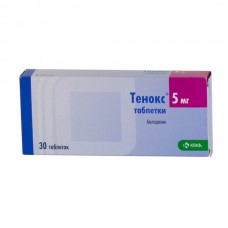Expiration date: 12/2026
Composition and form of issue:
Tablets, 1 tablet contains:
amlodipine (in the form of maleate) 5 or 10 mg
excipients: MCC starch pre-gelatinized carboxymethyl starch silicon sodium dioxide colloidal anhydrous magnesium stearate
in packages contour cell 10 PCs. in cardboard pack 3 or 9 packs.
Description of dosage form:
Round, biconvex tablets white or almost white, with chamfer and risk on one side.
Pharmacokinetics:
After oral administration, amlodipine is slowly absorbed from the gastrointestinal tract. The average absolute bioavailability of 64%, Cmax in serum was observed after 6-9 h. the Concentration of stable equilibrium is achieved after 7 days of therapy. Food does not affect the absorption of amlodipine. The average volume of distribution is 21 l / kg, which indicates that most of the drug is in the tissues, and relatively less — in the blood. Most of the drug in the blood (95%) is bound to plasma proteins. Amlodipine undergoes slow but extensive metabolism (90%) in the liver with the formation of inactive metabolites, has the effect of "first pass" through the liver. Metabolites have no significant pharmacological activity. After a single oral administration of T1/2 varies from 31 up to 48 h, when re-assigning T1/2 is approximately 45 h. About 60% of an oral dose is excreted in the urine mainly as metabolites, 10% in an unmodified form, and 20-25% in the feces, and breast milk. The total clearance of amlodipine is 0, 116 ml/s/kg (7 ml/min/kg, 0, 42 l/h / kg).
In elderly patients (over 65 years), the excretion of amlodipine is delayed (T1/2 — 65 h.) compared with young patients, but this difference is not of clinical significance. Lengthening T1/2 in patients with hepatic insufficiency suggests that the long — term administration of the drug in the body will be higher (T1 / 2-up to 60 h). Renal failure does not significantly affect the kinetics of amlodipine. The drug penetrates the BBB. When hemodialysis is not removed.
Description of pharmacological action:
The derivative of dihydropyridine-blocker of "slow" calcium channels of the II generation, has antianginal and hypotensive effect. Communicating with digidropiridinovmi receptors, does calzieve channels, lowers transmembranny transition of calcium ions into the cell (more in gladkomyshechne cells receptacles, than cardiomiotita). Antianginal effect is due to the expansion of the coronary and peripheral arteries and arterioles: with angina reduces the severity of myocardial ischemia expanding peripheral arterioles, reduces OPSS, reduces preload on the heart, reduces myocardial oxygen demand. Expands the main coronary arteries and arterioles in unchanged and ischemic areas of the myocardium, increases the flow of oxygen to the myocardium (especially in vasospastic angina) prevents the development of coronary artery constriction (including Smoking). In patients with angina pectoris, a single daily dose increases the time of physical activity, slows the development of angina and" ischemic " depression of the ST segment, reduces the frequency of angina attacks and the need for nitroglycerin.
It has a long dose-dependent hypotensive effect. Hypotensive effect due to direct vasodilating effect on the smooth muscles of blood vessels. In hypertension, a single dose provides a clinically significant decrease in blood PRESSURE for 24 hours (in the patient's "lying" and "standing"). Does not cause the sharp decline in AD, reduced tolerance to physical exertion, ejection fraction of the left ventricle. Reduces the degree of myocardial hypertrophy of the left ventricle, exerts anti-atherosclerotic and cardioprotective action in coronary heart disease. It does not affect the contractility and conductivity of the myocardium, does not cause a reflex increase in heart rate, inhibits platelet aggregation, increases glomerular filtration rate, has a weak natriuretic effect. In diabetic nephropathy does not increase the severity of microalbuminuria. It has no adverse effects on the metabolism and plasma lipids. The time of the effect-2-4 hours, the duration of the effect-24 hours.
Indications:
- hypertension (monotherapy or in combination with other antihypertensive agents)
- stable and vasospastic angina (Prinzmetal's angina) — monotherapy or in combination with other antihypertensive agents.
Contraindications:
- increased sensitivity to amlodipine and other dihydropyridine derivatives
- severe hypotension
- collapse
- cardiogenic shock
- pregnancy and lactation
- the age of 18 years (efficacy and safety not established).
With caution:
- hepatic impairment
- sinus node weakness syndrome (severe bradycardia, tachycardia)
- decompensated chronic heart failure
- mild and moderate degree of arterial hypotension
- aortic stenosis
- mitral stenosis
- hypertrophic obstructive cardiomyopathy
- acute myocardial infarction (and within 1 month after)
- old age.
Side effect:
From the cardiovascular system: heartbeat, shortness of breath, marked decrease in blood PRESSURE, fainting, vasculitis, swelling (swelling of the ankles and feet), blood flow to the face, rarely — rhythm disorders (bradycardia, ventricular tachycardia, atrial flutter), chest pain, orthostatic hypotension, very rarely — the development or worsening of heart failure, extrasystole, migraine.
From the Central nervous system: headache, dizziness, fatigue, drowsiness, mood changes, convulsions rarely — loss of consciousness, hypesthesia, nervousness, paresthesia, tremor, vertigo, asthenia, malaise, insomnia, depression, extraordinary dreams, very rarely — ataxia, apathy, agitation, amnesia.
From the digestive system: nausea, vomiting, epigastric pain, rarely — increase in liver transaminases and jaundice (due to cholestasis), pancreatitis, dry mouth, flatulence, hyperplasia of the gums, constipation or diarrhea, very rarely — gastritis, increased appetite.
On the part of the genitourinary system rarely-pollakiuria, painful urge to urinate, nicturia, violation of sexual function (including decreased potency), very rarely — dysuria, polyuria.
On the part of the skin: very rarely — xeroderma, alopecia, dermatitis, purpura, skin color change.
Allergic reactions: itching, rash (including erythematous, maculopapular rash, urticaria), angioedema.
From the musculoskeletal system: rarely-arthralgia, arthrosis, myalgia with prolonged use, very rarely — myasthenia gravis.
Other: rare — gynecomastia, poliuretane, increase/decrease in body weight, thrombocytopenia, leukopenia, hyperglycemia, impaired vision, conjunctivitis, diplopia, eye pain, tinnitus, back pain, dyspnea, epistaxis, excessive sweating, thirst very rarely — cold clammy sweat, cough, rhinitis, parosmia, a violation of taste sensations, violation ccomodation, xerophthalmia.
Drug interaction:
Possible in the treatment of hypertension simultaneous use of amlodipine with thiazide diuretics, alpha-blockers, beta-blockers or ACE inhibitors. In patients with stable angina, the drug can be combined with other antianginal agents, for example, with nitrates of prolonged action, beta-blockers or nitrates for oral administration.
Amlodipine can be used simultaneously with NSAIDs (especially indomethacin), anti-infective agents and hypoglycemic agents for oral administration.
Thiazide and loop diuretics, alpha-, beta-adrenoblokatora, verapamil, ACE inhibitors and nitrates increase antianginalny and hypotensive effects.
Amiodarone, quinidine, alpha1-adrenoblokatora, antipsychotic drugs (neuroleptics) and other CCB may increase the hypotensive action.
It has no effect on the pharmacokinetic parameters of digoxin and warfarin.
Cimetidine does not affect the pharmacokinetics of amlodipine.
When combined with drugs lithium may increase the manifestation of their neurotoxicity (nausea, vomiting, diarrhea, ataxia, tremor, tinnitus).
Calcium supplementation may reduce the effect of BCC.
Procainamide, quinidine and other drugs, causing prolongation of the QT interval, increase the negative inotropic effect and may increase the risk of significant prolongation of the QT interval.
The pharmacokinetics of amlodipine does not change with the simultaneous administration of cimetidine.
Grapefruit juice can reduce the concentration of amlodipine in the blood plasma, but this reduction is so small that it does not significantly change the effect of amlodipine.
Dosage and administration:
Inside.
In hypertension, the initial dose is 5 mg 1 time / day maintenance-2, 5-5 mg / day maximum-10 mg / day.
In angina pectoris and angiospastic angina, the drug is prescribed in a dose of 5-10 mg / day in one dose.
Patients with low body weight or small stature, the elderly, when liver function as antihypertensives Tenoks administered in an initial dose of 2 to 5 mg, as antianginalnogo in a dose of 5 mg.
When using the drug as part of combination therapy with thiazide diuretics, & beta-blockers and ACE inhibitors dose adjustment is not required.
When prescribing the drug to patients with renal insufficiency does not require changes in the dosage regimen.
Overdose:
Symptoms: marked decrease in blood PRESSURE, tachycardia, excessive peripheral vasodilation.
Treatment: gastric lavage, the appointment activated carbon, the maintenance functions of the cardiovascular system, monitoring of indicators of function of heart and lungs, exalted position of extremities, control of the BCC and diurezom. To restore vascular tone — the use of vasoconstrictive drugs (in the absence of contraindications to their use) to eliminate the effects of the blockade of calcium channels — intravenous calcium gluconate. Hemodialysis is not effective.
Special instruction:
During treatment with Tenox, it is necessary to control the body weight and sodium intake, the appointment of an appropriate diet. It is necessary to maintain dental hygiene and frequent visits to the dentist (prevention of pain, bleeding and gum growth). In elderly patients, the half-life and clearance of the drug may be prolonged. The dosage regimen for the elderly is the same as for patients of other age groups. When increasing the dose should be carefully monitored for elderly patients.
Despite the absence of withdrawal syndrome in BCC, a gradual reduction of doses is recommended before discontinuation of treatment.
Influence on the ability to drive and mechanisms. There were no reports of the impact of Tenox on driving or working with mechanisms. However, some patients, mainly at the beginning of treatment, may experience drowsiness and dizziness. When they occur, the patient should take special precautions when driving and working with mechanisms.



